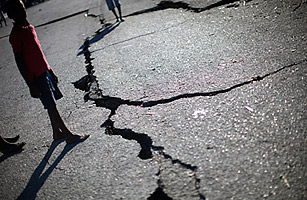
A child in Port-au-Prince stands before a large crevice that was caused by the earthquake
The British Geological Survey in Edinburgh has been one of the leading geoscience research centers in the world since its founding in 1835. To understand more about the 7.0-magnitude earthquake that devastated Haiti on Tuesday, TIME spoke with one of the survey's seismologists, Roger Musson, about the science behind the seismic event.
What sort of earthquake was this?
An earthquake is the sudden release of energy along a fault line in the earth's crust as rocks break in response to stress. There are three types, and they depend on the sort of movement along the fault. This was what we call a strike-slip, or transform, earthquake, where one side of the fault slides horizontally past the other one.
Which fault produced this earthquake?
It is rather baroquely called the Enriquillo-Plaintain Garden fault. It is a major plate boundary fault and is analogous to the San Andreas fault in California. It starts around the southern border between Haiti and the Dominican Republic and runs west until it reaches Jamaica.
Was it the most destructive type of earthquake?
A thrust earthquake, in which one side of the fault goes up, is the type that produces truly enormous events like the Sumatra earthquake of 2004. But strike-slip faults often run through populated areas, so they can be the most damaging to humans.
People talk about waiting for the Big One in California. Was this a similar earthquake for this fault?
This was the Big One. The fault has been more or less locked for 200 years. Seismologists were unsure as to whether it would produce one Big One or several smaller ones. We seem to have the answer.
Does that mean the fault will be quiet now that the pressure has been
released?
The pressure has probably shifted to the west, so it's likely that there will be another earthquake or perhaps a succession of earthquakes moving westward to Jamaica. That is not in the immediate future but in the next decades or 100 years. My guess would be that we will have another earthquake in Haiti or Jamaica within 20 or 40 years.
What about aftershocks?
Aftershocks, which are a sort of settling down of the earth's crust in the vicinity of the main shock, have been continuing [in Haiti], and the biggest was 5.9 [magnitude] and happened eight minutes after the main shock. But they seem to be slowing down.
Will we learn anything scientifically from this earthquake?
Every earthquake teaches us something, but this is not really a remarkable earthquake — a similar one occurred in 1770 and 1751 on the fault.
Was this a fault that seismologists were concerned about, not for geological
reasons but because of the vulnerability of the population there?
Seismologists are human. We are aware of such things. When I saw the data for this earthquake last night, I can tell you that my heart sank.